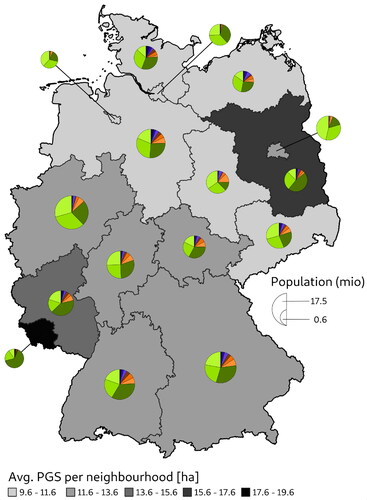Figures & data
Figure 1. Workflow of this study. The GLC dataset is derived from a land cover classification (*) developed by Weigand et al. (Citation2020) and PGS is derived from a deep learning data fusion (see sec. 3.1.2). both datasets are used in conjunction with nationwide census data to support the analyses in this study.

Table 1. Aggregation scheme for census building type classification.
Figure 2. Availability of neighbourhood GLC and PGS in Germany by cumulative shares of the population. The separate plots use different grouping variables: A) Entire Germany, B) by municipality size in by population in thousands (K), C) by the 5-class rural urban gradient by Taubenböck et al. (Citation2022), and D) in neighbourhoods with specific building types.

Figure 3. Green space availability in Germany by federal states. States are shaded by the population-weighted average of PGS available. Pie charts indicate the distribution of PGS and GLC, the colors follow the legend in .

Figure 4. Equity of GLC (pink) and PGS (green) availability in Germany at national, regional and city level. A) depicts a lorenz curve showing the availability of the resources in Germany. Point plots visualize the distribution of Gini coefficients measuring distributive equity of the resources in different spatial samples: B) by the municipality size denoted in classes of thousands (K) of inhabitants per municipality, C) by the neighbourhood classification along the rural-urban gradient, and D) by neighbourhoods with distinct housing types. For reference, the horizontal lines in B), C), and D) visualize the Gini coefficient per resource for the entire population of Germany.

Figure 5. Comparison of green space availability by cumulative population share (coloured bars) and PGS Gini coefficient (black dots) for the 100 most populated cities in Germany. The colours follow the legend in . The cities are ranked by the proportion of the population that has more than 3.6 hectares of the PGS in the neighbourhood which is the WHO target (green coloured bars). the main findings include: the range of population with above-target PGS values varies significantly among the largest cities, the PGS Gini coefficient only weakly correlates with the PGS above-target population shares (r = -0.52) with distinct outliers like darmstadt or heilbronn.

Table 2. LMM estimated fixed effects (FE) and random effects (RE) modelling the relation between green land cover (GLC, in ha.) and population (log.), the share of foreigners, children, and elderly across populated 1 km 1 km grid cells in Germany.
Table 3. LMM estimated fixed effects (FE) and random effects (RE) modelling the relation between public green space (PGS, in ha.) and population (log.), the share of foreigners, children, and elderly across populated 1 km × 1 km grid cells in Germany.
Table 4. LMM estimated fixed effects (FE) and random effects (RE) modelling the relation between green land cover (GLC, in ha.) and population (log.), the share of foreigners, children, and elderly across populated 1 km × 1 km grid cells in Germany.
Table 5. LMM estimated fixed effects (FE) and random effects (RE) modelling the relation between public green space (PGS, in ha.) and population (log.), the share of foreigners, children, and elderly across populated 1 km × 1 km grid cells in Germany.
Supplemental Material
Download Zip (3.7 KB)Data availability statement
Data available from the authors on request. The code used for this study is published at https://github.com/dlr-eoc/ukis-paperfairgreen.
